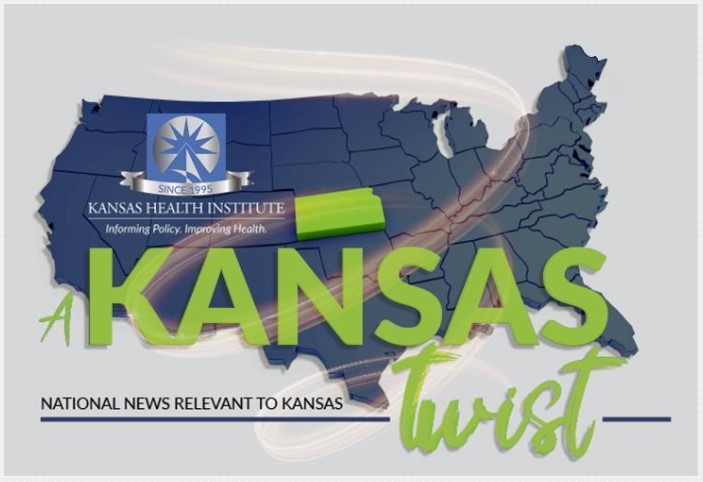On Aug.12, 2021, the U.S. Census Bureau released statistics from the 2020 Census Redistricting Data showing population changes, housing occupancy and race/ethnicity distribution by county. In a report published in 2018, A Changing Kansas: Implications for Health and Communities, the Kansas Health Institute (KHI) and the Kansas Health Foundation (KHF) found that the population in Kansas was aging and becoming increasingly diverse and more concentrated in urban areas. This newly released data from the Census Bureau show that those trends have continued. This edition of A Kansas Twist dives into this new data to examine these demographic trends.
Sign up here to receive these summaries and more, and also follow KHI on Facebook, Twitter and LinkedIn. Previous editions of A Kansas Twist can be found on our ARCHIVE PAGE.
Kansas Population Continues to Age
Statewide, the population of Kansas grew by 3.0 percent (84,762 residents) between 2010 and 2020. But the population has continued to age, with 2,229,316 Kansas adults age 18 and over comprising 75.9 percent of the population in 2020, compared to 2,126,179 Kansas adults age 18 and over comprising 74.5 percent of the population in 2010.
Kansas Population Continues to Become More Urban
Most of the state’s population growth between 2010 and 2020 was in urban counties (those with a population density of at least 150 residents per square mile). The proportion of Kansans living in urban counties increased 2.4 percentage points from 54.9 percent in 2010 to 57.3 percent in 2020. During those 10 years, the state’s urban counties experienced a population growth of 7.5 percent (117,471), just under the 9 percent average growth rate for metropolitan areas nationally.
The five fastest growing counties in Kansas — Pottawatomie, Johnson, Wyandotte, Leavenworth and Douglas— grew by 10.4 percent on average. All five counties are located in the northeast part of the state and all but Pottawatomie are urban. Sedgwick County, which includes Wichita and is the second most populous county in the state, grew 5.1 percent. However, the population gains in these counties were somewhat offset by population declines in less populated areas of the state.
While Pottawatomie, Geary, Finney, Scott, Miami and McPherson Counties grew faster than the state overall between 2010 and 2020, 80 of the 105 counties in Kansas experienced a loss of population. The population in semi-urban counties (40 to 149.9 residents per square mile) declined by 0.6 percent (2,594). In densely settled rural counties (20 to 39.9 residents per square mile), the population decreased by 2.2 percent (10,600). In rural counties (six to 19.9 residents per square mile), there was a decrease of 4.9 percent (11,608). In frontier counties (less than six residents per square mile), there was a decrease of 6.9 percent (7,907).
Kansas Population Continues to Become More Diverse
Despite the population decrease in most Kansas counties, the minority population — defined as any racial or ethnic group other than non-Hispanic White — increased in all but three counties, and the proportion of minorities among the population increased in all counties. The collective population of minority groups increased by 31.6 percent, from 619,582 in 2010 (21.7 percent of the total population) to 815,305 in 2020 (27.8 percent of the total population). During this same period, the non-Hispanic White population decreased by 5.0 percent, from 2,233,536 in 2010 to 2,122,575 in 2020. Southwest Kansas continues to be the most diverse region in the state, with nearly half (47.3 percent) of residents in those counties identifying as a race or ethnicity other than non-Hispanic White.
Growing minority group populations in Kansas include non-Hispanic Asians, Pacific Islanders or Native Hawaiians (26.6 percent increase), Hispanics of any race (27.5 percent increase) and non-Hispanic others or those identifying with multiple races (152.2 percent increase). However, the population decreased 0.1 percent among non-Hispanic Blacks and 5.3 percent among non-Hispanic American Indians or Alaskan Natives. For 2020, the U.S. Census Bureau revised the race/ethnicity questions and coding to make it easier for respondents to identify with more than one race. This change may account for a significant portion of the increase in the total minority group population, as Kansans identifying as non-Hispanic other or multiple races increased by 96,000 between 2010 and 2020.
In the 2018 report, KHI and KHF predicted that, based on trends from 2000 to 2016, the population in Kansas would look very different in 50 years. The overall population of the state was projected to increase by approximately 25 percent by the year 2066, with most of that growth concentrated in urban areas and with nearly every part of the state much more racially and ethnically diverse. The 2020 Census results provide evidence that these trends have continued and reinforce health-related implications noted in the 2018 report, including:
-
- As the population ages, rates of chronic disease such as heart disease and diabetes will likely increase and put additional strain on the public health and health care systems across the state.
- Local governments in rural communities will find it increasingly difficult to fund and provide essential services as their tax bases continue to shrink.
- Small, local school districts will struggle to recruit and retain qualified teachers and staff to educate their students.
Before the COVID-19 pandemic, racial and ethnic disparities existed in social and environmental determinants of health such as poverty, education and housing. Minority populations in Kansas were more likely to experience higher poverty rates, lower high school graduation rates and educational attainment, and have less access to health care. The COVID-19 pandemic has likely made these challenges worse. State and local leaders must engage with all communities to address disparities by socioeconomic status, race/ethnicity and geography to support the health and well-being of future generations of Kansans.
